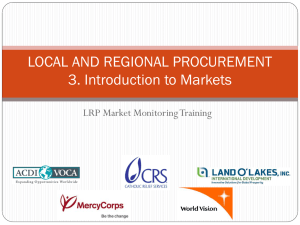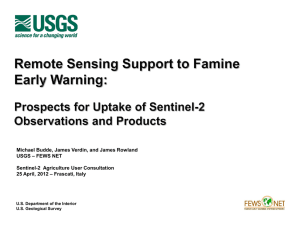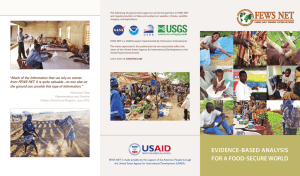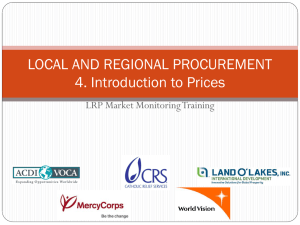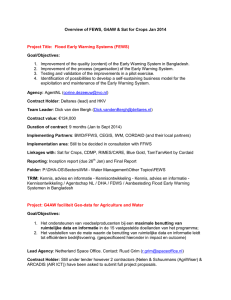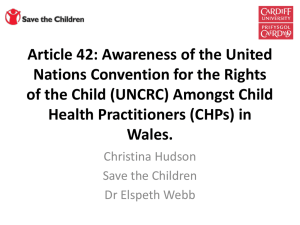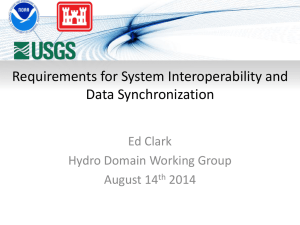New River Forecast System
advertisement
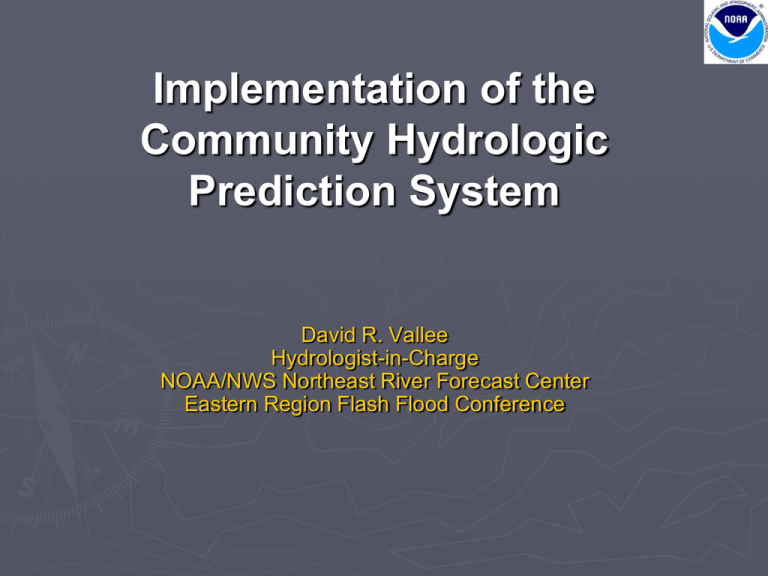
Implementation of the Community Hydrologic Prediction System David R. Vallee Hydrologist-in-Charge NOAA/NWS Northeast River Forecast Center Eastern Region Flash Flood Conference Topics ► Background ► What is CHPS? ► Hydrology community benefits ► Project Organization ► Risk reduction forecast offices ► Transition challenges ► Operations benefits 2 Background ► Today’s NWS River Forecast System (NWSRFS) has been the NWS hydrologic forecasting foundation for over 30 years ► NWSRFS architecture hinders use of recent advances in interactive forecasting and modeling ► NWS needs an improved hydrologic modeling infrastructure to leverage community operational concepts and models as well as provide future products and services ► The Community Hydrologic Prediction System (CHPS) will replace NWSRFS ► For more information, see the NWS OHD CHPS web site (http://www.nws.noaa.gov/ohd/hrl/chps/index.html) 3 What is CHPS? ► CHPS is both a system and a concept Open forecasting system to promote model & data sharing NOAA reaching out to hydro community ► CHPS uses Delft-FEWS from Deltares (Dutch Foundation) as core infrastructure FEWS: Flood Early Warning System Model adapter concept for algorithm modularity Sophisticated data and workflow handling for models Comprehensive forecaster user interface and displays (the IFD) Highly configurable modeling environment via XML files ► Initially, includes NWSRFS models and USACE models (HEC-RAS and HEC-ResSim) ► Later, can include models from other providers 4 CHPS and FEWS FEWS Models Models from Federal, State, Local, University and international researchers Other Models FC FEWS CHPS NWS Models USACE Models 5 FEWS Development – Past 10 Years Today 2007 ► First FEWS system: 1992 in Sudan Blue Nile, Atbara & White Nile Used Sacramento Rainfall-Runoff, HD routing & Reservoir models ► 1997/1998 more flexible FEWS system deployed in Pakistan & Czech Republic ► 1999 European Flood Forecasting System (EFFS) was developed Modernize flood forecasting capabilities Birth of the Java style FEWS Also became the operational system in Switzerland & the Netherlands ► 2002 Environment Agency, UK adopted FEWS as its Forecasting System Birth of FEWS 2.0 – configured as a client-server system 2006 FEWS Scotland, FEWS Po (Italy) FEWS DE (Germany), FEWS Singapore 2005 FEWS Regge & Dinkel, Netherlands FEWS Beijing (China), FEWS Oberöstereich (Austria) 2004 FEWS-JRC (EU-Italy), FEWS Niederöstereich (Austria) 2002 NFFS (England & Wales) 2001 FEWS Taiwan 1999 EFFS (EU) FEWS-NL, The Netherlands FEWS-CH, Switzerland 1998 FEWS Orlice (Czech Republic) 1997 FEWS Pakistan, Pakistan 1996 FEWS Vistula (Pilot), Poland 1990 1990 6 FEWS Sudan, The Sudan Global User Community 7 The NWS Path to FEWS ► ► ► 2003: OHD initiated exploration of a replacement for NWSRFS 2005: Several candidates considered – including Delft-FEWS 2006: ABRFC, NCRFC, NWRFC and CNRFC volunteered to work with OHD to evaluate candidates (CHPS Acceleration Team or CAT) ► ► 2007: Selected Delft-FEWS as the candidate for CHPS 2008: Gary Carter approved decision; proceed with implementation of Delft-FEWS as the CHPS software infrastructure NERFC brought on board to replace NCRFC as a CAT member NOHRSC added as well NWSEO brought on board to help develop path toward operational testing, evaluation and impact and implementation 8 Hydrology Community Benefits ► Key motivation for community is to broaden and accelerate research to operations Meteorological example: The Weather Research and Forecasting (WRF) Model (http://www.wrf-model.org/index.php) Enhance understanding of hydrologic forecasting within hydrologic research community ► Hydrology community includes ► NOAA line offices other U.S. Federal agencies (e.g., USACE, USGS, USBR) U.S. Universities (e.g., http://www.cuahsi.org/) International researchers NWS to make CHPS and hydro models available 9 Risk Reduction River Forecast Offices ► Goal to create and validate transition path for 9 follow-on RFCs based on CAT RFCs’ experiences with one year lead in schedule ► Support for follow-on 9 RFCs from the 4 risk reduction RFCs Each CAT RFC to assist 2 – 3 “buddies” “Buddy” visits were conducted in March through July of 2010 Migration activities at these 9 RFCs are in progress ► Also key to risk reduction was establishment of a clear set of “Baseline” Operational Capabilities to avoid requirements creep ► CAT RFCs have moved into some degree of parallel execution with NWSRFS 10 The CHPS Interactive Forecaster Display 11 Transition Challenges ► Challenges are technical Must not disrupt daily forecasting Must assure hydro models perform the same within new infrastructure Must assure model performance not degraded while taking opportunity to move to gridded meteorological forcings ► Challenges are cultural NWS forecasters require training NWS researchers and programmers need to re-orient to highly configurable environment ► Field support requires new paradigm that includes support of external models ► Operating in a truly community oriented environment within the U.S. and abroad 12 Operations Benefits ► More flexibility to address upcoming major service enhancements Short term ensemble forecasts Gridded hydrologic modeling Gridded water resources forecasts ► Simpler and accelerated research to operations path ► Take advantage of communitydeveloped models ► Simpler and lower cost of software maintenance and addition of small enhancements NWS developers concentrate on hydrology not infrastructure 13 WFO Benefits ► ► ► More efficient and timely delivery of forecasts With the infusion of new science and modeling – improved forecasts for short/long range Collaborative hydrologic/hydraulic modeling activities Site Specific International Partners – New Brunswick, Canada, NERFC and WFO Caribou, ME ► ► Potential for a CHPS Client to reside at the WFO Improved collaboration between RFCs and WFOs 14 Implementation of the Community Hydrologic Prediction System Questions???? David R. Vallee Hydrologist-in-Charge NOAA/NWS Northeast River Forecast Center Eastern Region Flash Flood Conference
